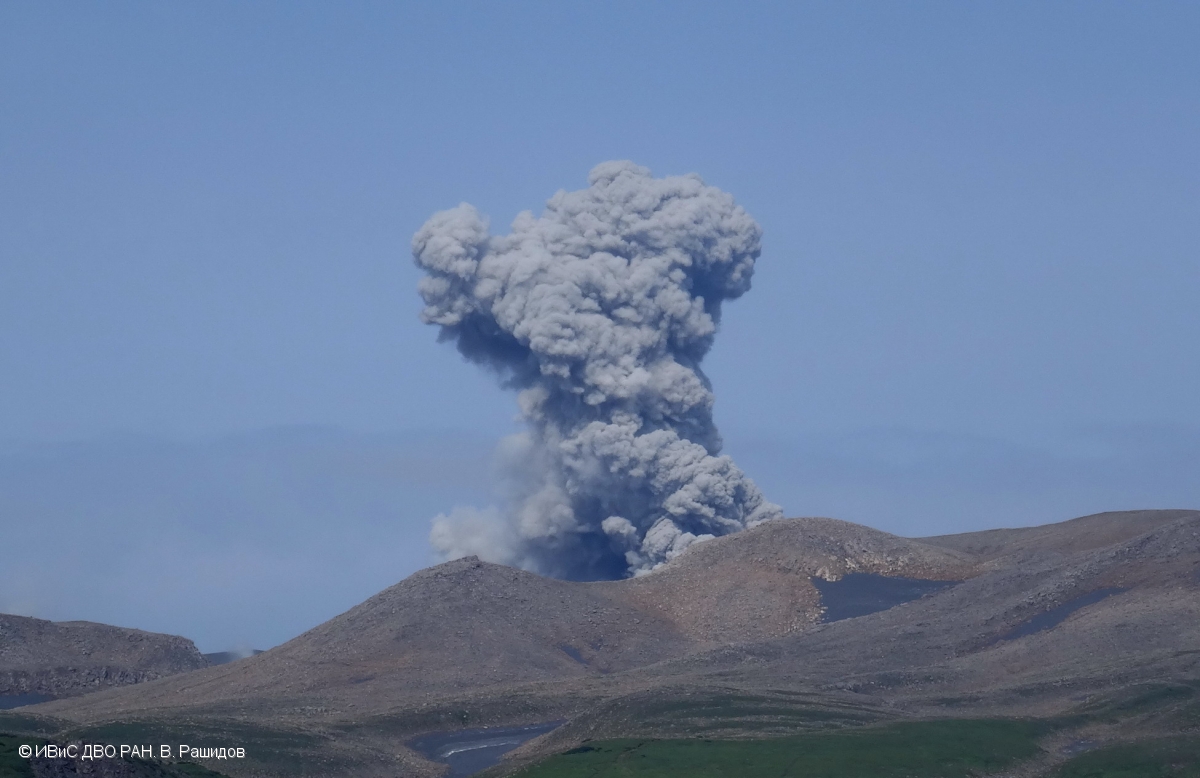Report on Ebeko (Russia) — March 2018
Bulletin of the Global Volcanism Network, vol. 43, no. 3 (March 2018)
Managing Editor: Edward Venzke.
Research and preparation by Sara Arav-Piper.
Ebeko (Russia) Continuing frequent ash explosions through November 2017, typically to about 2 km altitude
Please cite this report as:
Global Volcanism Program, 2018. Report on Ebeko (Russia) (Venzke, E., ed.). Bulletin of the Global Volcanism Network, 43:3. Smithsonian Institution. https://doi.org/10.5479/si.GVP.BGVN201803-290380
Ebeko
Russia
50.686°N, 156.014°E; summit elev. 1103 m
All times are local (unless otherwise noted)
Ebeko volcano is located on the remote N end of Paramushir Island in the Kuril Islands and contains many craters, lakes, and thermal features. Eruptions and ash plumes were observed at Ebeko in early July 2010 (BGVN 36:07). No additional activity was reported from Ebeko until October 2016, marking the start of the more recent eruptive cycle. New explosive eruptions accompanied by ash fall began on 20 October 2016 through April 2017 (BGVN: 42:08). Explosive eruptions, ash plumes, ash falls were observed and reported at a regular frequency during this reporting period from May through November 2017 (table 5). Eruptions were reported by observations from residents in the town of Severo-Kurilsk, located about 7 km E of Ebeko, by volcanologists and by satellite imagery. The Kamchatkan Volcanic Eruption Response Team (KVERT) is responsible for monitoring Ebeko, and is the primary source of information. The Aviation Color Code (ACC) remained at Orange throughout this reporting period. This color is the second highest level of the four color scale.
Table 5. Summary of activity at Ebeko volcano from May 2017 to November 2017. Aviation Color Code (ACC) is a 4-color scale. Data courtesy of KVERT.
| Date | Plume Altitude | Plume Distance | Plume Direction | Other Observations |
| 23 Apr-26 Apr 2017 | 2.1 km | 50 km | NE | ACC at Orange. Minor ashfall in Severo-Kurilsk reported on 25 April |
| 07 May 2017 | -- | -- | -- | Satellite observation |
| 08 May-09 May 2017 | 2.4-2.7 km | -- | S, NE | Satellite observation |
| 15 May 2017 | 2 km | -- | -- | Explosions |
| 23-24 May 2017 | 2 km | -- | -- | Explosions |
| 25 May-02 Jun 2017 | -- | -- | -- | Explosions |
| 02 Jun-09 Jun 2017 | -- | -- | -- | Explosions |
| 09 Jun-16 Jun 2017 | -- | -- | -- | Explosions |
| 17, 21 Jun 2017 | 2 km | -- | -- | Explosions |
| 23 Jun-30 Jun 2017 | 2 km | -- | -- | Explosions, ashfall in Severo-Kurilsk reported on 24 and 26 Jun |
| 01, 04 Jul 2017 | 2.6 km | -- | -- | Explosions |
| 07 Jul-08 Jul 2017 | 1.5 km | -- | -- | Explosions |
| 31 Jul 2017 | -- | -- | -- | Weak thermal anomaly |
| 01 Aug 2017 | 1.6 km | -- | -- | Explosions |
| 10 Aug 2017 | -- | -- | -- | Explosions |
| 22 Aug 2017 | 2 km | -- | SW | Explosions |
| 28 Aug-29 Aug 2017 | 2.2 km | -- | -- | Explosions, minor ashfall in Severo-Kurilsk |
| 02 Sep 2017 | 4 km | -- | -- | Explosions |
| 03, 06-07 Sep 2017 | 2.1 km | -- | -- | Explosions, minor ashfall in Severo-Kurilsk |
| 13 Sep-14 Sep 2017 | 2.2 km | -- | -- | Explosions |
| 15 Sep-17 Sep 2017 | 3 km | -- | -- | Explosions, minor ashfall in Severo-Kurilsk |
| 24 Sep 2017 | 2 km | -- | -- | Explosions |
| 29-30 Sep, 01, 05 Oct 2017 | 1.5 km | -- | -- | Explosions |
| 06-07, 09, 12 Oct 2017 | 3 km | -- | -- | Explosions, ashfall in Severo-Kurilsk reported on 7, 9, and 12 Oct |
| 13-20 Oct 2017 | 2.5 km | -- | -- | Explosions |
| 20-27 Oct 2017 | 2 km | -- | -- | Explosions |
| 27 Oct-03 Nov 2017 | 2 km | -- | -- | Explosions |
| 05, 07-08 Nov 2017 | 2 km | -- | -- | Explosions |
| 16 Nov 2017 | 2 km | -- | -- | Explosions |
| 17-18, 20-21 Nov 2017 | 2 km | -- | -- | Explosions, ashfall in Severo-Kurlisk reported on 22 Nov |
| 25-26, 28-30 Nov 2017 | 2 km | -- | -- | Explosions, ashfall in Severo-Kurlisk reported on 28 Nov |
Explosives events, bursts of ash, ashfall, and ash plumes were reported throughout this period, and were quite variable in appearance (figures 12-16). Minor amounts of ash fell in Severo-Kurilsk on 25 April, 2-3, 6-7, 16, and 18 September, and 22 November. Ash plume altitudes during this reporting period ranged from 1.5 to 4 km; with the highest altitude of 4 km recorded on 2 September (table 5).
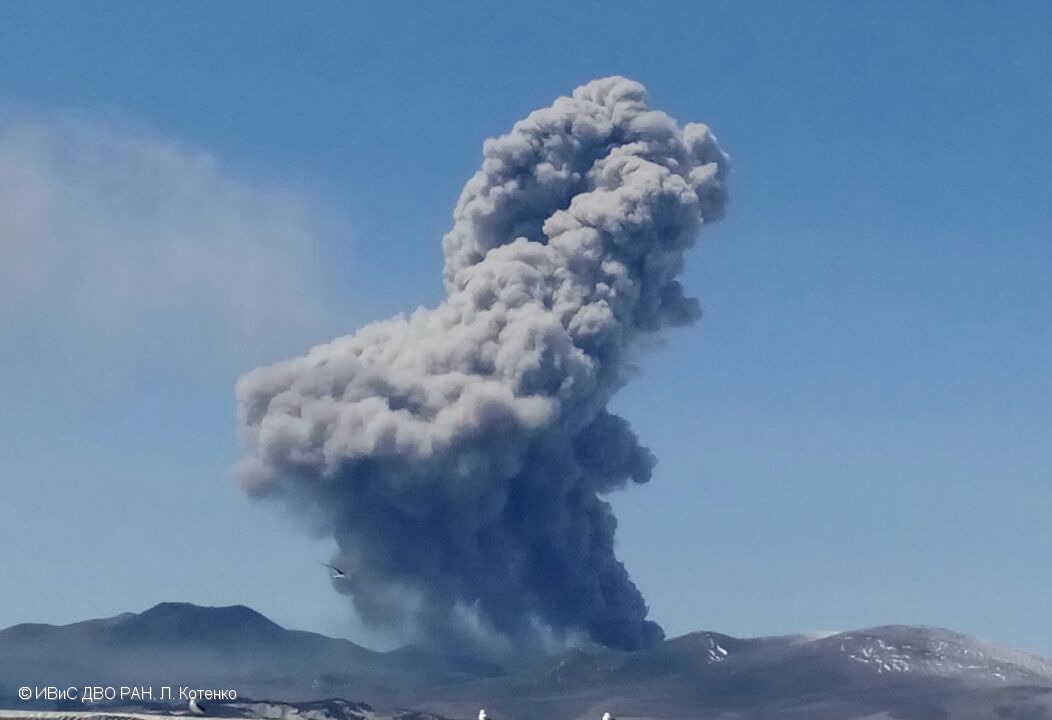 |
Figure 12. Ash plume from an explosive event at Ebeko on 15 May 2017. Ash plume altitude reached 2 km. Photo by L. Kotenko, courtesy of Institute of Volcanology and Seismology IVS FEB RAS. |
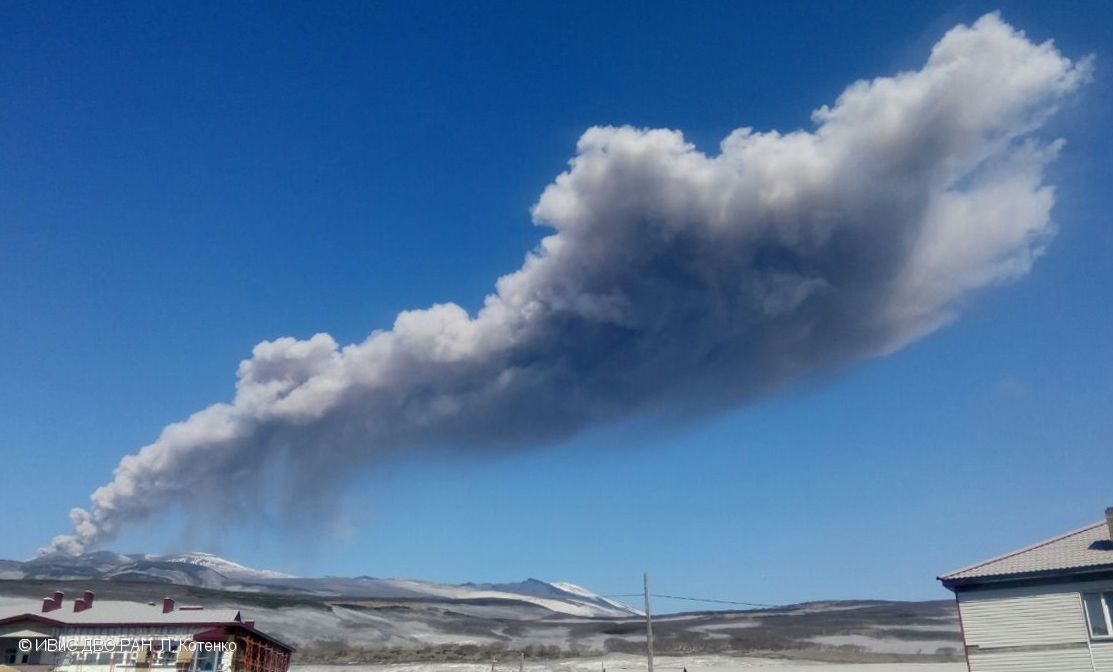 |
Figure 13. Ash plume from an explosive event at Ebeko on 23 May 2017. Ash plume altitude reached 2 km. Photo by L. Kotenko, courtesy of Institute of Volcanology and Seismology IVS, FEB, RAS. |
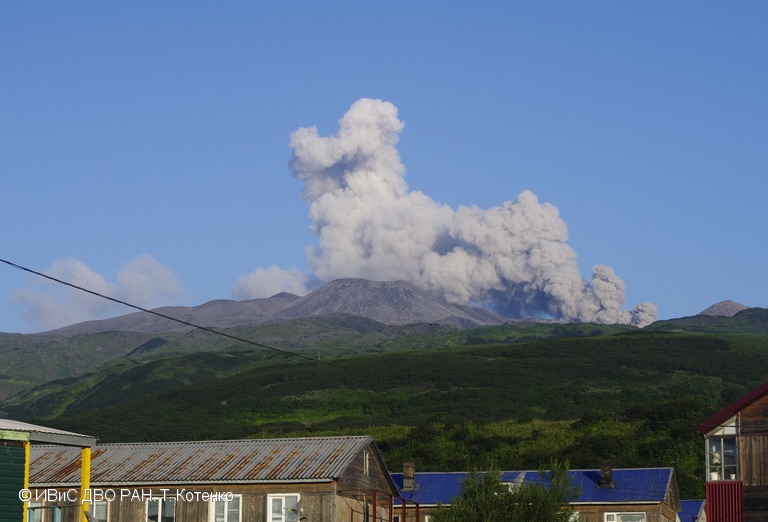 |
Figure 14. Ash explosions from Ebeko on 10 August 2017 as seen from Severo-Kurilsk, 7 km E. Photo by V. Rashidov, courtesy of Institute of Volcanology and Seismology IVS FEB RAS. |
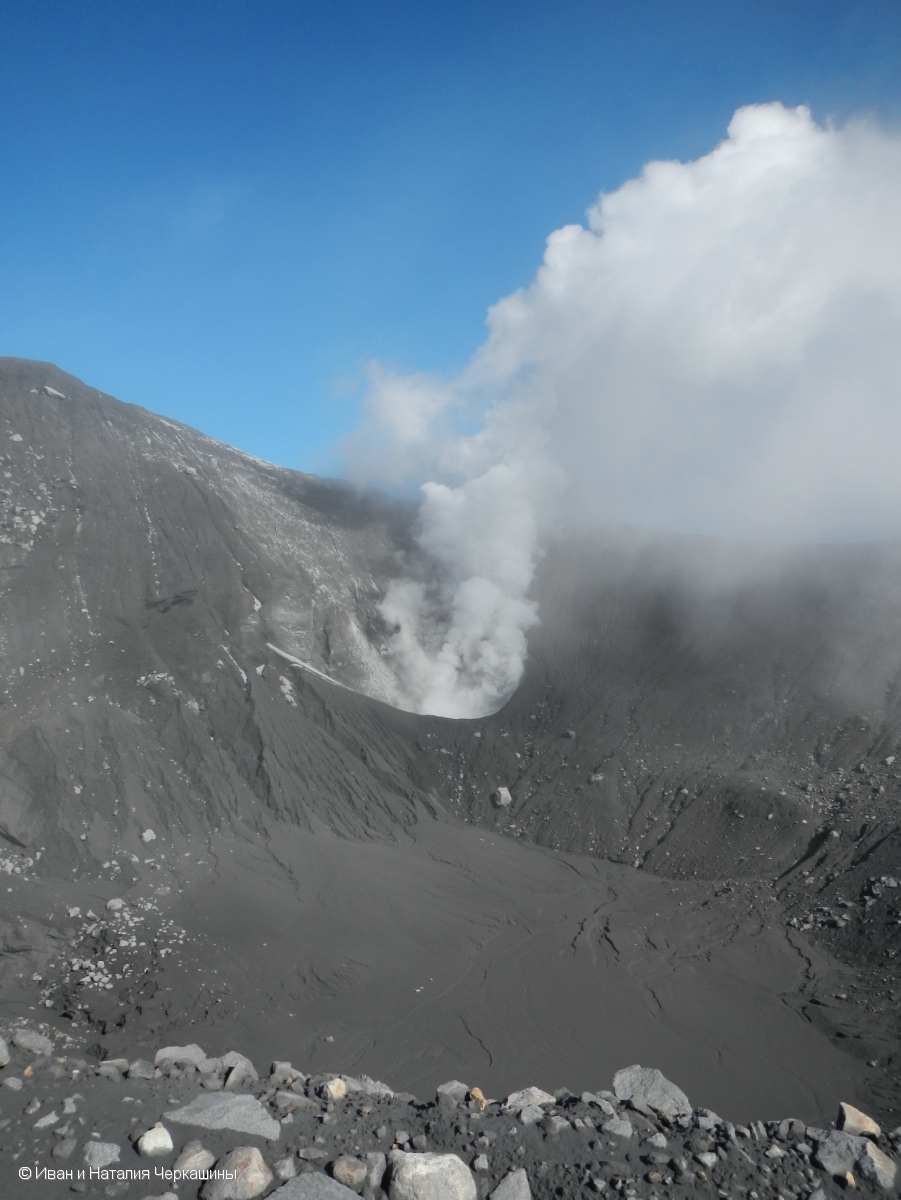 |
Figure 15. Ash bursts up to 2 km on 22 August 2017. Photo by T. Kotenk. Courtesy of Institute of Volcanology and Seismology IVS FEB RAS. |
MIROVA only identified two low-power thermal anomalies in the past year, one in late February 2017 and the other in late March 2017. A weak thermal anomaly was reported by KVERT on 31 July 2017.
Geological Summary. The flat-topped summit of the central cone of Ebeko volcano, one of the most active in the Kuril Islands, occupies the northern end of Paramushir Island. Three summit craters located along a SSW-NNE line form Ebeko volcano proper, at the northern end of a complex of five volcanic cones. Blocky lava flows extend west from Ebeko and SE from the neighboring Nezametnyi cone. The eastern part of the southern crater contains strong solfataras and a large boiling spring. The central crater is filled by a lake about 20 m deep whose shores are lined with steaming solfataras; the northern crater lies across a narrow, low barrier from the central crater and contains a small, cold crescentic lake. Historical activity, recorded since the late-18th century, has been restricted to small-to-moderate explosive eruptions from the summit craters. Intense fumarolic activity occurs in the summit craters, on the outer flanks of the cone, and in lateral explosion craters.
Information Contacts: Kamchatka Volcanic Eruptions Response Team (KVERT), Far Eastern Branch, Russian Academy of Sciences, 9 Piip Blvd., Petropavlovsk-Kamchatsky, 683006, Russia (URL: http://www.kscnet.ru/ivs/kvert/); Institute of Volcanology and Seismology, Far Eastern Branch, Russian Academy of Sciences (IVS FEB RAS), 9 Piip Blvd., Petropavlovsk-Kamchatsky 683006, Russia (URL: http://www.kscnet.ru/ivs/eng/); MIROVA (Middle InfraRed Observation of Volcanic Activity), a collaborative project between the Universities of Turin and Florence (Italy) supported by the Centre for Volcanic Risk of the Italian Civil Protection Department (URL: http://www.mirovaweb.it/).


